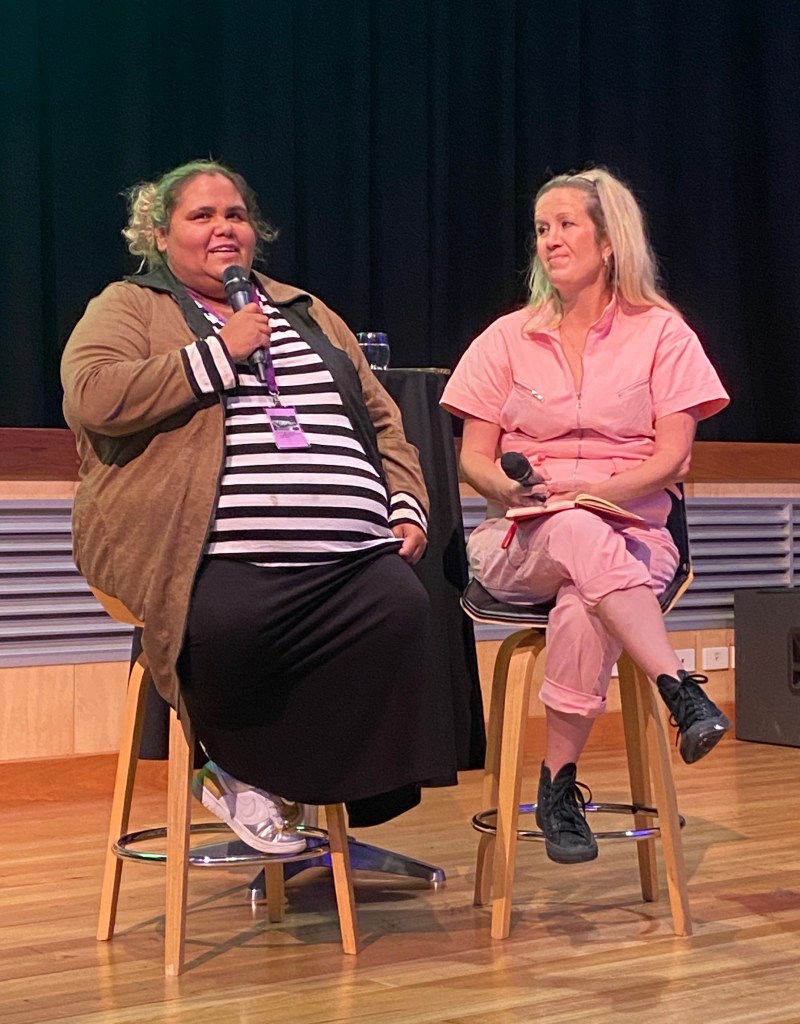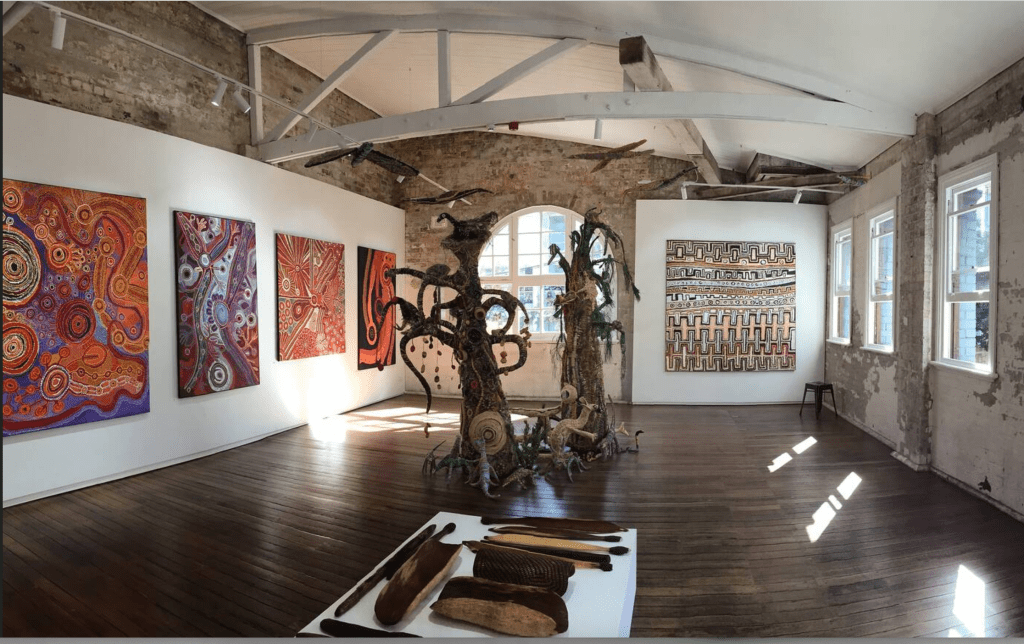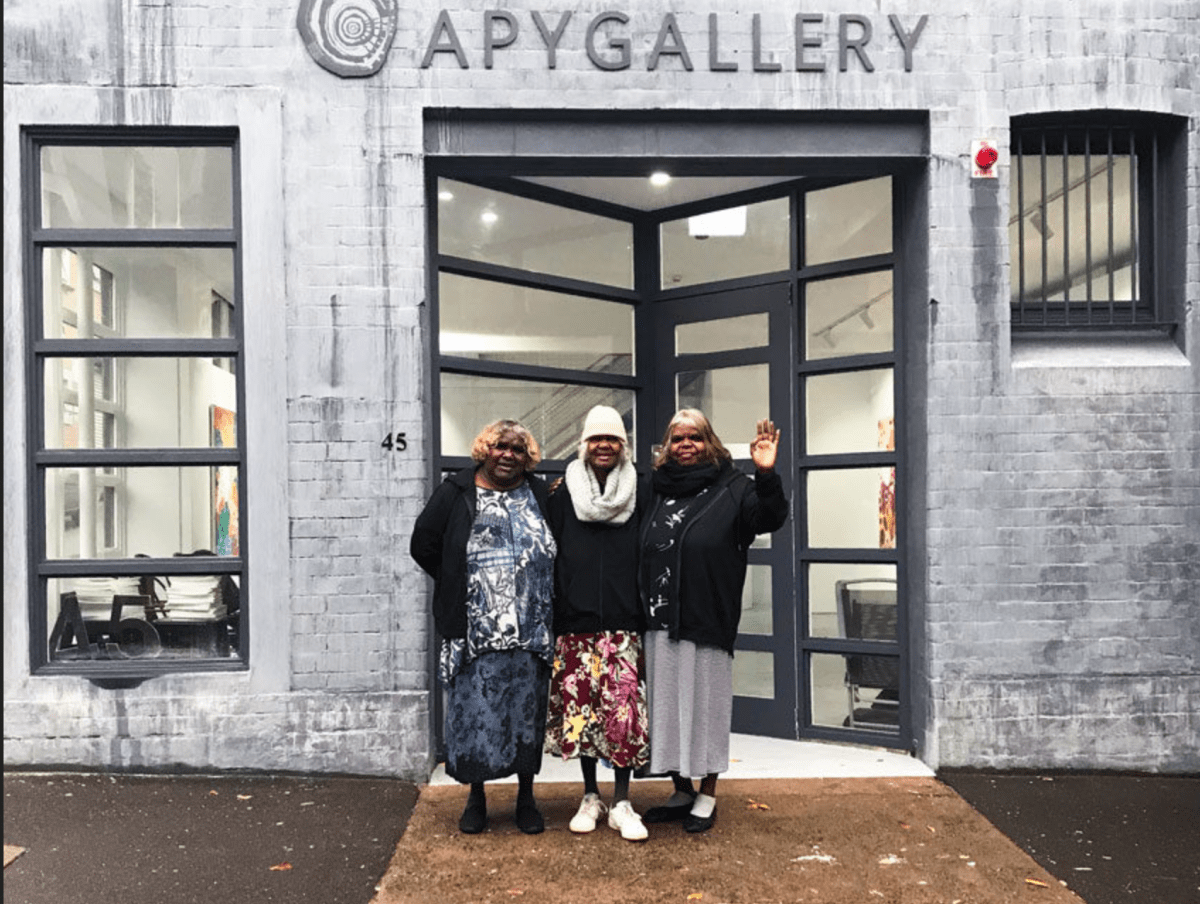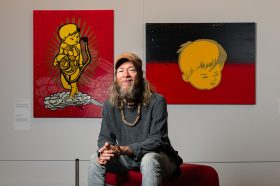‘First Nations leaders work with a drive – it is hardcore – and ambition underpins everything,’ says General Manager of APY Art Centre Collective, Skye O’Meara.
O’Meara presented a discussion with First Nations artist Sally Scales at the Regional Galleries and Museums Conference, held in Bega (NSW) earlier this month. Scales, a key player in the Collective, agrees with O’Meara, adding that geography need not dampen that ambition.
‘For us to drive down to Adelaide, it takes two days, so we’re talking remote.’ But, despite this, Scales says the APY Lands are home to the oldest continuing Art Centre in Australia, Ernabella Arts, which started in the 1940s. The region will also soon be home to the newest Art Centre – testament to that continuing ambition.
Over the past five years, the APY Art Centre Collective has opened three galleries – in Sydney, Melbourne and Adelaide – and bought their own space in Adelaide (where they run a studio program). They are also currently supporting the development of new Art Centres in Coober Pedy (the Umoona Community Arts Centre) and Oodnadatta, with Port Augusta on the horizon … and dreams for a Perth gallery.
It is an incredible trajectory for any commercial gallery. But what makes this story inspiring is that, in remote Aboriginal communities, ‘art centres are the only drivers of non-government money,’ says Scales. ‘It is the only place where a community member has full control and autonomy over their space. It’s also a space where, if you’re an elderly person, you get to shine. If you’re a person with disability, you get to fully shine. And it’s a place where we have so much intergenerational teaching happening, all the time.’
‘The dream that started as a little dream – it felt like we were asking for the world back in 2016 when we wanted a gallery in Sydney – is now like a tiny plan,’ adds O’Meara. ‘That’s the whole thing we reflect on now – what is the bigger dream?’
She continues: ‘We’re in a place now where three galleries happened really quickly, and the increase in artists’ participation around the Art Centres on the Lands has been massive. When we started, it was live or die; we had no money in the bank. We were trying something new that everyone said was impossible. But now it’s different.’
O’Meara says that when they were laying down the vision for the galleries, the Elders called for an 80/20 (artist/gallery) split on sales. ‘They wanted an 80% return to the community, in an industry where the standard structure was 50/50 or 60/40. We were told that the model wouldn’t work. But the Elders were saying, “OK, that’s your opinion. Not only is it going to work, it’s going to work at 80/20.” The Elders just needed the support, and the confidence, to be able to share their plan.’
Who owns entrepreneurship?

While the APY Art Centre Collective is a dream case study for success, it wasn’t always an easy path forward.
O’Meara explains: ‘The APY Communities are an environment of disadvantage, like lots of remote Indigenous communities, with much higher levels of family violence, and food security issues – some of the worst in the country. There was a petrol sniffing epidemic in the 1980s that swept through the APY Lands and government didn’t get to the issue, which means there is a middle band across APY communities with acquired brain injuries. And this disability impacts every family.’
And yet this community has worked against that adversity.
O’Meara continues: ‘Sometimes there are romantic notions about what artists should be, but as soon as you bring in that rigour around that commercial drive, everyone wants to talk about the lovely colours. There are 2500 people living on the APY Lands – 3000 when the footy’s on or you’re putting on a ceremony. That’s 3000 people living below the poverty line in Australia. It shouldn’t be that difficult to impact change. And this is what the Elders were talking about when they started the Collective. How do we give every single person a job in our communities?’
O’Meara says it’s about being in control of the opportunities. ‘It became the motivating factor. We saw what the galleries did, and when the artists were being told “no” – that it was a mistake to open a Sydney gallery – it only happened because of the Westpac Foundation, [artist] Ben Quilty and friends of the Art Gallery of New South Wales, who got involved.’
Scales continues: ‘The driver comes from that leadership of those Elders. “We have nothing, right? Then we have nothing to lose,” they say. It’s about bringing money to those kids. What you’re asking for isn’t unusual – it is actually just an ARI [artist run space] in Sydney.’
She adds: ‘The senior women are literally sitting there going, “We are using your Western laws, we’re using your Western languages. But this is our business. This is what we can control”.’
Scales says those same senior women keep pushing further, and are now wanting the Collective to think of Brisbane. ‘Listen, there’s the Olympics. And we need to be there before the Olympics,’ says Scales, quoting the Elders.
Today, there are around 500 artists working on APY Lands. ‘We want to give them their first platform and send them off into the world,’ O’Meara says of their overarching vision.

A legacy of ‘no’, means a determination to embrace ‘yes’
O’Meara explains that when they first dreamed of the Collective and opening their own gallery space in Sydney, ‘we were being told by government departments, “absolutely no, this business model will not work.” But it’s never new territory being told no’.
Scales adds, ‘The Elders keep saying, “This is what we want – we need you to hear what we’re wanting.” They say, “I’m used to those disappointments from higher-ups … no one gets to tell us what to do anymore”.’
O’Meara continues, ‘When we started, people talked about a legacy of disappointment. Things don’t work, so you “ante-up” again in the arts. What sets our region apart is the ability to collaborate, and we’ve tried to operate with a “bush to boardroom” model of ethical First Nations art production.
‘Where we sit now, in terms of the big vision, is an ethical pathway that is controlled by First Nations leadership, and being able to support the Indigenous art market with confidence that you are not in any risk of supporting an unethical channel – that you can guarantee that artists have been supported to work in appropriate professional but also safe environments.
‘Indigenous ambition underpins everything,’ says O’Meara.
Part of that gusto is about pushing through, rather than sitting back and spinning into a cycle of stasis. ‘When you happen to partner with bigger machines – to partner in the bureaucratic spaces – you sit there and wonder, why is this taking so long? Our little team would have this sorted out in 10% of the time. I think that’s something we’re getting better at, and it’s one of the things that happens as you grow.’
O’Meara continues: ‘I think – with the rapid growth in the idea of what the Art Centres could be and should be – [there was a realisation that] the whole thinking needed to be flipped. The business model of the APY Art Centre Collective demonstrates innovation, business acumen, and that leadership and drive that the Elders started with, and has led to three galleries.’
Scales makes the point that Indigenous people have a shorter life expectancy. ‘So for those artists to get to that peak, and sit in that space, they’re lucky if they get 12 years. My Elders were like, “no, no, no, we want our young ones to have this proper career, to have a career like white artists get,” and to have your avenues and stepping stones, so that you can hit your peak at certain age brackets and actually get to have it for a long time.’
She adds that it is the women who are pushing for that bread and butter. ‘They want an income for their family. The incredible thing was, when Elders started the Collective, [there was the feeling that] “we’re all family and it makes sense for us to share our resources. We’re going to share our knowledge, we’re going to share the tools and assets so that we’re not continuously reinventing the wheel. Let’s go. And let’s go together. We’ve got a quicker pathway”.’
Scales reflects on her own experience of growing up with this ambition. ‘As an artist looking at what my senior leadership have done for a young girl like me, having our own space to shine, but also as contemporary artists, we were not boxed and framed in the First Nations dot painting narrative. I don’t want to talk about what my painting is about. I think that was the talk of anthropologists. I get to have my own space and autonomy. It used to be, 10 years ago, that the only thing we entered into was NATSIAA. What’s exciting is that there’s more open to us.’
O’Meara says one of the greatest challenges has been, ‘maintaining an abundance mindset – that is the toughest thing’.
‘When it’s such a limited pool of resources, and you’ve got your government funding for these projects, where can I go next? What’s the next avenue? If you’re not finding new pathways, it sets up a dynamic, like a scarcity mindset. It also creates unnecessary tensions between your peers.
‘So the leadership requires us to maintain a line of focus to grow opportunities, and a determination to grow income,’ concludes O’Meara – noting that, indeed, this is exactly what they are doing.
This conversation between Sally Scales and Skye O’Meara took place in Bega (NSW) on the occasion of the Regional Galleries and Museums Conference, March 2023. ArtsHub attended as a guest.





